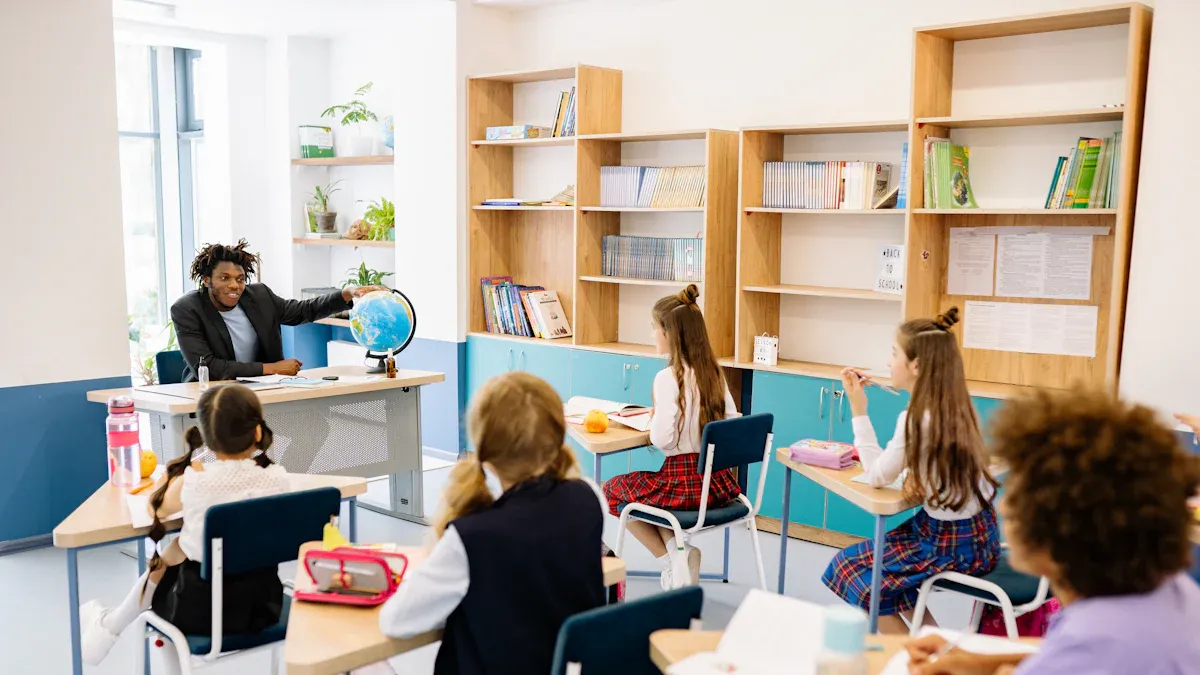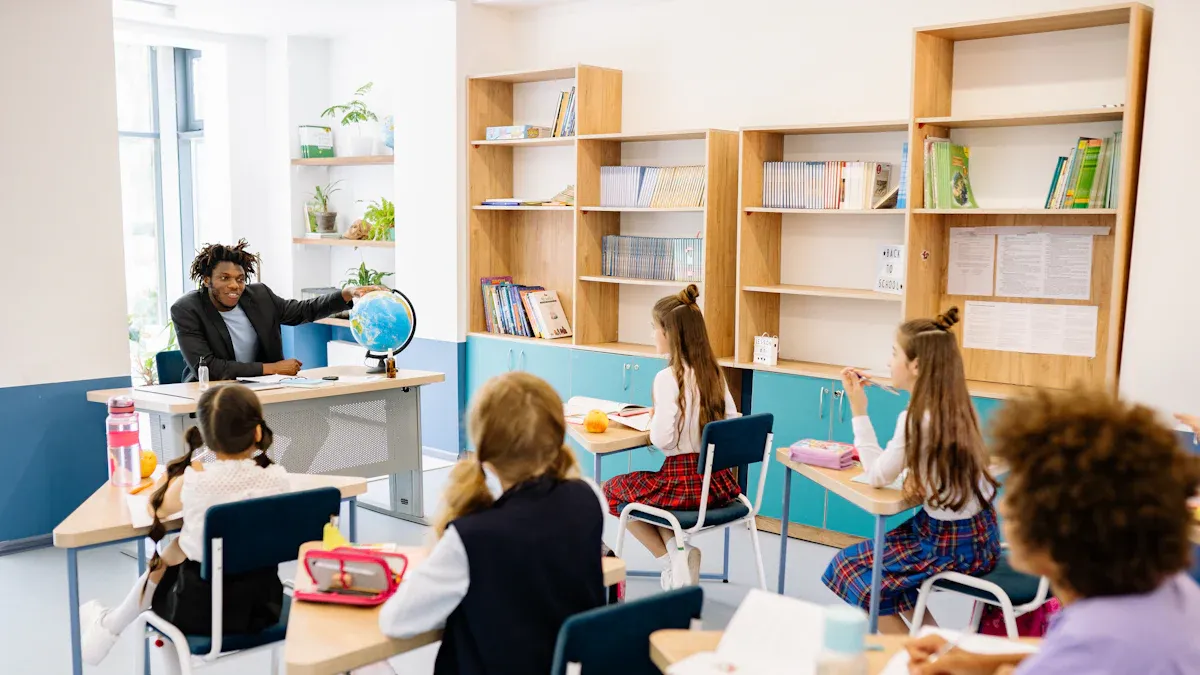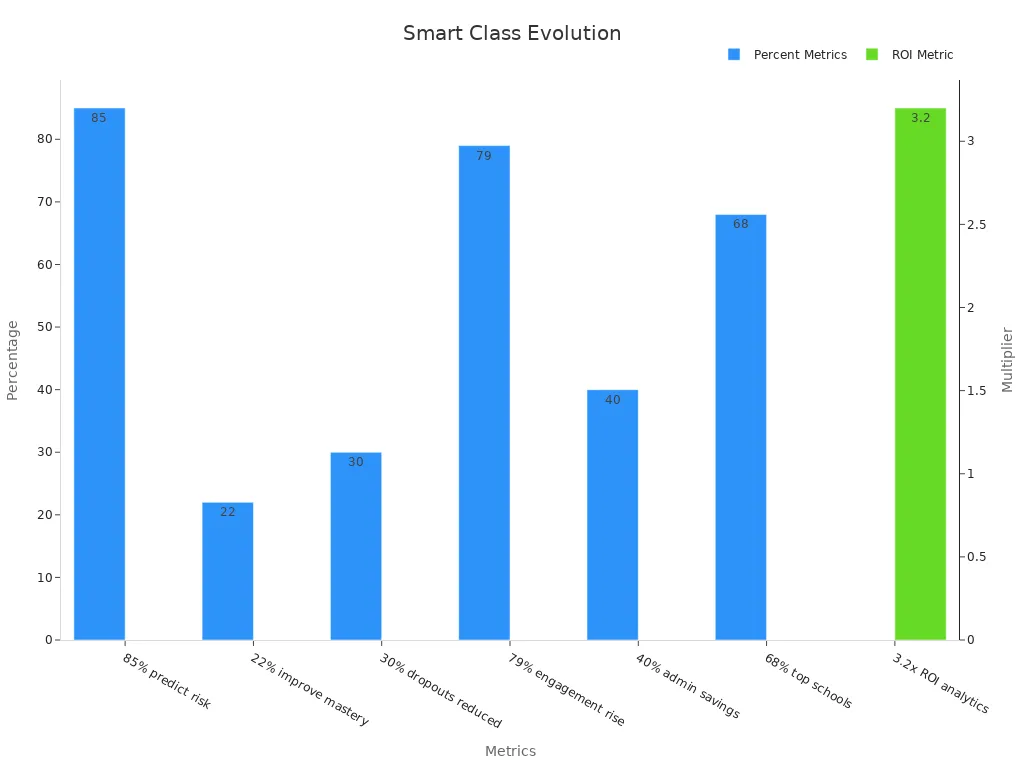
A smart classroom design layout transforms traditional learning spaces into dynamic environments that foster engagement and innovation. It integrates technology, flexible furniture, and thoughtful arrangements to support diverse teaching methods. This approach enhances learning by creating spaces where students feel motivated and focused. For instance, interactive tools in such classrooms reduce off-task behavior by 37% and increase participation by 93%.
Designing these spaces requires careful planning. You need to balance space limitations, budget constraints, and the unique needs of your students. A well-planned layout ensures accessibility, comfort, and collaboration, making learning more effective and enjoyable for everyone.
Look at your classroom to see how it’s used now. This helps you plan a better setup.
Use furniture that can move to fit different lessons. Movable desks and chairs help students work together and learn in new ways.
Pay attention to things like light and fresh air. A comfy classroom helps students stay focused and learn better.
Make sure the classroom works for all students. This way, everyone can join in and feel included.
Mix good looks with usefulness. A nice-looking classroom can inspire students and still be great for learning.
Before creating a smart classroom design layout, you need to evaluate the available space and infrastructure. Start by measuring the dimensions of your classroom and identifying how the space is currently being used. For example, is the room primarily a lecture hall, a lab, or a multipurpose space? Classifying the space helps you determine its potential for transformation.
Measurement Type | Description |
|---|---|
Use | Classification of the space (e.g., library, laboratory, classroom) |
User | Number of users (e.g., 300 students vs. less than 30) |
Usage | Actual use of the space (e.g., whether a classroom is unoccupied or used for storage) |
You should also consider the number of students who will use the space. A room designed for 30 students will have different requirements than one accommodating 300. Observing how the space is utilized during the day can reveal inefficiencies, such as areas used for storage instead of learning. Tools like the Classroom Environment Evaluation Scale (CEES) can help you assess how well the space supports technology integration and overall functionality.
Environmental factors play a significant role in creating a smart classroom design layout. Proper lighting, acoustics, and ventilation ensure comfort and focus, which directly impact learning outcomes.
Indoor Air Quality: Good ventilation reduces pollutants and keeps the air fresh, which is essential for students and teachers who spend hours indoors.
Thermal Comfort: Maintaining a comfortable temperature prevents distractions caused by feeling too hot or cold.
Visual Comfort: High-quality lighting, including natural daylight, minimizes glare and supports visual tasks. Windows offering outdoor views can also enhance the learning experience.
Acoustic Comfort: Reducing noise from both inside and outside the classroom ensures clear communication and minimizes disruptions.
Studies show that these factors significantly affect student performance. For instance, research by Barrett et al. (2015) found that differences in classroom stimulation, individualization, and naturalness explained 16% of the variance in student learning progress. Similarly, Pilcher et al. (2002) noted that extreme temperatures could reduce cognitive performance by up to 14.88%.
A smart classroom design layout should cater to the diverse needs of students and align with various teaching styles. Begin by analyzing how students interact with the current setup. Are they able to collaborate effectively? Do they have access to the resources they need?
Factor | Description |
|---|---|
Physical Design | The layout and structure of the classroom environment. |
Flexibility | The adaptability of the classroom setup to different teaching styles. |
Technology Use | The integration of digital tools and resources in the learning process. |
Learning Data | Information gathered on student performance and engagement. |
Differentiation | Tailoring instruction to meet diverse student needs. |
Investigation | Opportunities for students to explore and inquire. |
Cooperation | Collaborative learning experiences among students. |
Students’ Cohesiveness | The sense of belonging and community among students. |
Equity | Ensuring all students have access to resources and support. |
Learning Experience | Overall satisfaction and effectiveness of the learning environment. |
Flexibility is key. A classroom that supports both group discussions and individual work can accommodate different teaching methods. Technology integration also plays a vital role. Digital tools should enhance learning without overwhelming students or teachers. Surveys involving over 13,000 students revealed that pedagogy fit is crucial for the effective application of smart classrooms. This means the design must align with teaching goals to maximize its impact.

A flexible classroom layout allows you to adapt the space to suit various teaching methods. Whether you are conducting a lecture, facilitating group discussions, or guiding hands-on activities, the ability to rearrange the classroom quickly can make a significant difference. Flexible arrangements also cater to different learning styles, ensuring every student has the opportunity to thrive.
For example, incorporating modular furniture, such as movable desks and chairs, enables you to create configurations that support both individual and group work. Research highlights that flexibility in classroom design enhances engagement and focus. Students prefer environments that allow for collaborative deadlines, non-timed assignments, and hybrid learning options. These preferences align with educators' goals to create dynamic and inclusive learning spaces.
Dimension of Flexibility | Student Preference | Educator Preference |
|---|---|---|
Collaborative deadlines | High | Moderate |
Non-timed assignments | High | Low |
Take-home assignments | Moderate | Moderate |
Frequent, lower-weight grading | High | Low |
Hybrid courses over online | Higher | N/A |
By prioritizing flexibility, you can create a smart classroom design layout that accommodates diverse teaching methods and fosters a more engaging learning environment.
Collaboration is a cornerstone of modern education. A classroom designed for teamwork encourages students to share ideas, solve problems together, and build essential social skills. Flexible seating arrangements play a crucial role in fostering collaboration. For instance, movable tables and chairs allow students to form groups easily, while open spaces provide room for brainstorming and hands-on projects.
A less restrictive environment promotes creativity and adaptability. Students can transition seamlessly between individual tasks and group activities. This adaptability supports various types of collaborative work, from discussions to project-based learning. Additionally, hybrid learning environments that combine physical and digital tools enhance teamwork by allowing students to collaborate both in-person and online.
Flexible seating enables students to engage in various collaborative activities, enhancing teamwork.
Adaptable classroom spaces support different types of group work, from discussions to hands-on projects.
The ability to reconfigure spaces for different activities supports both independent and collaborative work.
By designing a collaboration-focused layout, you create an environment where students can work together effectively, boosting engagement and learning outcomes.
An accessible and inclusive classroom ensures that every student, regardless of their abilities or background, can participate fully in the learning process. This approach not only benefits students with disabilities but also fosters a sense of belonging for all learners. When you minimize barriers to learning, you create a level playing field where every student can succeed.
Inclusive designs often feature wide pathways, adjustable furniture, and technology that supports diverse needs. For example, interactive displays with adjustable heights and voice-activated tools can accommodate students with physical or sensory challenges. Research shows that such environments promote engagement, collaboration, and academic success for all students.
Creating inclusive and accessible learning environments fosters diversity and well-being.
These environments benefit all learners by promoting engagement and academic success.
Minimizing barriers allows students with disabilities to fully participate and achieve their potential.
By incorporating accessibility and inclusivity into your smart classroom design layout, you ensure that every student feels valued and supported, leading to better learning outcomes for everyone.
Creating a smart classroom design layout involves more than just arranging furniture and integrating technology. You also need to consider how the space looks and feels. A well-designed classroom should strike a balance between aesthetics and functionality. This balance ensures the environment is both visually appealing and practical for learning.
The way a classroom looks can influence how students feel and behave. Bright, inviting colors can boost energy and creativity, while softer tones promote calmness and focus. Adding visual elements like artwork, plants, or themed decorations can make the space more engaging. These touches create a welcoming atmosphere that encourages students to participate and feel comfortable.
Tip: Use color psychology to guide your choices. For example, blue tones can enhance focus, while green promotes relaxation and balance.
While aesthetics are important, functionality should always come first. A classroom must support learning activities without distractions. For example, avoid cluttering walls with too many decorations, as this can overwhelm students. Instead, focus on practical elements like clear sightlines to the board, easy access to resources, and organized storage.
Functional design also includes choosing durable materials. Furniture and equipment should withstand daily use while remaining comfortable. For instance, ergonomic chairs and desks can improve posture and reduce fatigue, helping students stay focused during lessons.
You don’t have to choose between beauty and practicality. By combining both, you can create a space that inspires and supports learning. Here are some ideas to achieve this balance:
Use multifunctional furniture: Select pieces that serve more than one purpose, like storage benches or foldable desks. These save space and keep the room tidy.
Incorporate natural elements: Add plants or use wooden furniture to bring warmth and life to the classroom. Studies show that natural elements can reduce stress and improve concentration.
Create zones: Divide the classroom into areas for different activities, such as reading, group work, and technology use. Use rugs or color-coded furniture to define these spaces visually.
Keep it simple: A minimalist approach often works best. Choose a few key design elements that reflect your teaching style and avoid overloading the space.
When you balance aesthetics with functionality, you create a classroom that feels both inspiring and efficient. Students will enjoy spending time in a space that looks good and works well. Teachers will find it easier to manage lessons and keep students engaged. This balance is a key component of any successful smart classroom design layout.
Interactive displays and digital tools are essential for creating a modern learning environment. These tools allow you to engage students with dynamic content, making lessons more interactive and enjoyable. For example, interactive whiteboards enable you to display multimedia presentations, annotate in real-time, and involve students in problem-solving activities. Digital tools like tablets and laptops provide access to educational apps, fostering personalized learning experiences.
Benefits of interactive displays and tools:
Gamification increases student performance by up to 34.74%.
Immediate feedback from digital tools enhances learning outcomes.
Platforms like BioBrain and DoodleLearning boost engagement and confidence.
The SAMR model helps educators integrate technology effectively. It includes four levels: Substitution, Augmentation, Modification, and Redefinition, guiding you to transform teaching methods.
By incorporating these tools, you can create a smart classroom design layout that supports innovative teaching and prepares students for a digital future.
Flexible seating and modular furniture transform traditional classrooms into adaptable spaces. Movable desks and chairs allow you to reconfigure the room for different activities, such as group discussions or individual work. This flexibility enhances collaboration and comfort, making learning more effective.
Key features of flexible furniture:
Movable chairs and modular desks support diverse learning activities.
Dry-erase desktops encourage interactive learning.
Overton Ray Elementary School reported improved collaboration after implementing flexible seating.
Jon McKenzie highlights that traditional classrooms with fixed seating do not support active learning. Movable furniture, on the other hand, fosters collaboration and critical thinking. By adopting flexible furniture, you can create a dynamic environment that meets the needs of 21st-century learners.
Environmental controls play a crucial role in maintaining student comfort and focus. Proper lighting, ventilation, and temperature regulation ensure that students can concentrate without distractions. For instance, natural light reduces eye strain, while good ventilation improves air quality and cognitive performance.
Tips for optimizing the classroom environment:
Use adjustable lighting to suit different activities.
Maintain a comfortable temperature to prevent discomfort.
Ensure proper airflow to keep the air fresh and clean.
Studies show that classrooms with optimal environmental conditions enhance student performance. By prioritizing these factors, you can create a space where students feel comfortable and ready to learn.
Seamless technology integration transforms a classroom into a hub of innovation and engagement. When you connect devices, tools, and systems effectively, you create an environment where students can learn without interruptions. This integration ensures that technology supports teaching goals rather than becoming a distraction.
One key aspect of connectivity is ensuring that all devices work together smoothly. For example, interactive whiteboards, tablets, and laptops should sync effortlessly. This allows you to share content across platforms, making lessons more dynamic. Reliable Wi-Fi is essential for accessing online resources and enabling real-time collaboration. Without it, students may face delays that disrupt their focus.
Institutions like Middle Tennessee State University (MTSU) have adopted blended and hybrid learning models. These approaches enhance flexibility and promote active learning. At the University of California, Los Angeles (UCLA), IoT-connected smart classrooms improve engagement by monitoring environmental conditions. Similarly, the University of North Carolina uses interactive learning environments to foster collaboration and knowledge retention.
Institution | Technology Integration | Impact on Learning Experience |
|---|---|---|
Middle Tennessee State University | Blended and hybrid learning models | Enhances flexibility, promotes active learning, and supports academic success |
University of California, Los Angeles | IoT-connected smart classrooms | Improves learning conditions and promotes engagement through environmental monitoring |
University of North Carolina | Interactive learning environments | Fosters collaboration and knowledge retention through diverse educational methods |
To achieve seamless integration, you should also consider user-friendly tools. Platforms with intuitive interfaces reduce the learning curve for both students and teachers. For instance, cloud-based systems allow students to access assignments and resources from anywhere. This flexibility supports independent learning and ensures that no one falls behind.
By prioritizing connectivity and technology integration, you create a classroom where learning flows effortlessly. Students stay engaged, teachers save time, and the overall experience becomes more productive and enjoyable.
Upgrading a classroom doesn’t have to break the bank. You can achieve significant improvements by focusing on cost-effective strategies. Start by conducting a thorough budget review. Identify areas where resources are underutilized or wasted. For example, replacing outdated equipment with energy-efficient alternatives can save money in the long run.
Aspect | Description |
|---|---|
Cost-effectiveness | Optimizing resources to achieve desired outcomes within the budget. |
Educational impact | Ensuring investments improve student outcomes and overall educational quality. |
Comprehensive budget review | Scrutinizing each line item to eliminate wasteful spending. |
Schools that have implemented budget-friendly strategies often share success stories. These testimonials highlight how small changes, like repurposing furniture or using open-source digital tools, can make a big difference. By prioritizing essential upgrades and leveraging community support, you can create a smarter classroom without overspending.
Limited space can feel like a major obstacle, but creative solutions can help you maximize every square foot. Adjustable furniture is a game-changer. Desks and chairs that adapt to different heights and needs allow you to personalize the space for students. Sound absorption materials can also transform noisy classrooms into focused learning environments.
Adjustable Furniture: Enhances comfort and personalization for students.
Sound Absorption Products: Reduces noise pollution, improving focus.
Dedicated Spaces for Focused Work: Converts unused areas into quiet zones or meditation rooms, boosting mental well-being.
You can also think vertically. Adding shelves or wall-mounted storage frees up floor space while keeping the classroom organized. By reimagining how the space is used, you can create a functional and inviting environment, even in the smallest rooms.
Every student learns differently, so your classroom should cater to a variety of needs. Differentiated instruction ensures equitable opportunities for all learners. Specialized designs, like sensory-friendly areas or technology that supports visual and auditory learning, can make a big impact.
Differentiated instruction provides equitable learning opportunities for diverse learners.
Specialized designs meet varied learning needs, enhancing inclusivity.
For example, creating flexible zones for group work, independent study, and hands-on activities allows students to choose the environment that suits them best. This approach not only supports academic success but also fosters a sense of belonging. By designing with diversity in mind, you ensure that every student feels valued and empowered to learn.
Designing a smart classroom layout transforms traditional spaces into hubs of innovation and collaboration. By incorporating flexible furniture, interactive technology, and inclusive designs, you create an environment that supports diverse teaching methods and learning styles. These elements not only enhance engagement but also improve academic outcomes and foster global collaboration.
Benefit | Description |
|---|---|
Enhanced Engagement | Interactive technology and immersive experiences capture students’ attention and make learning more engaging and enjoyable. |
Personalized Learning | AI-powered tools adapt content to individual learning styles and progress, ensuring that no student is left behind or held back. |
Global Collaboration | Smart classrooms enable students to collaborate with peers from different parts of the world, fostering cultural awareness and global competence. |
Efficiency and Productivity | Teachers can streamline administrative tasks, access digital resources instantly, and spend more time on instructional activities. |
Data-Driven Insights | Smart classrooms collect data on student performance and engagement, allowing educators to tailor instruction and identify areas for improvement. |
Preparation for the Future | Exposure to advanced technology in the classroom prepares students for the tech-centric workplaces they will encounter in the future. |
Studies like Wilson et al. (2021) and Kim, Lee (2023) highlight how smart classrooms boost engagement and creativity. For example, 79% of students report increased participation, while dropout rates decrease by 30%. These outcomes demonstrate the transformative potential of smart classroom design layouts.

Take the first step toward creating a smart classroom by evaluating your current space and identifying areas for improvement. Small changes, like adding modular furniture or integrating digital tools, can make a big difference. By prioritizing innovation and inclusivity, you can prepare your students for a brighter, tech-driven future.